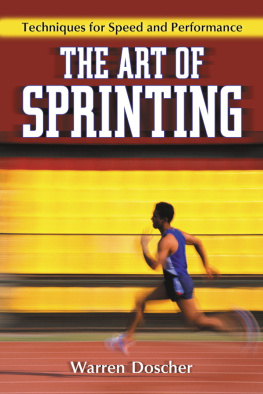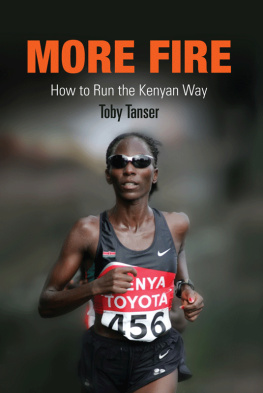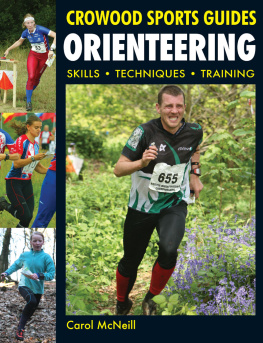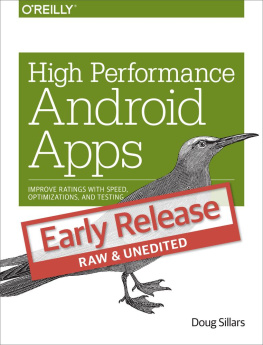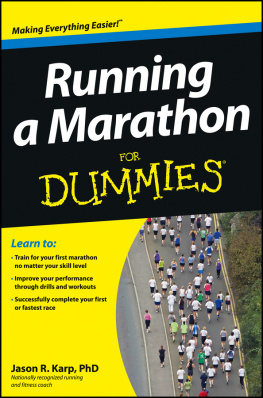
Table of Contents
The Art of
Sprinting
Techniques for Speed
and Performance
WARREN DOSCHER
McFarland & Company, Inc., Publishers
Jefferson, North Carolina, and London
LIBRARY OF CONGRESS CATALOGUING-IN-PUBLICATION DATA
Doscher, Warren, 1930
The art of sprinting : techniques for speed and performance / Warren Doscher.
p. cm.
Includes bibliographical references and index.
ISBN 978-0-7864-4314-7
1. Sprinting. 2. SprintingTraining. I. Title.
GV1069.D67 2009
796.42'2dc22 2009009454
British Library cataloguing data are available
2009 Warren Doscher. All rights reserved
No part of this book may be reproduced or transmitted in any form or by any means, electronic or mechanical, including photocopying or recording, or by any information storage and retrieval system, without permission in writing from the publisher.
Cover photograph 2009 Fotosearch
McFarland & Company, Inc., Publishers
Box 611, Jefferson, North Carolina 28640
www.mcfarlandpub.com
PREFACE
Sprinting is probably the oldest sport in which we humans engage. In the past century, we have come to understand better ways to run faster. Using experience and modern science we can now sprint faster than ever before. And using more experience and better science, we will be able to sprint still faster in the future. The Art of Sprinting opens the door just a bit wider so we can better see how to improve our present sprint abilities.
This is not a history of where the sport has been, nor is it a theoretical treatise on where it might be at some time in the future. The runner is shown how it is possible to run faster the next time he is on the track, and the next time he is on the starting line.
Much of what is covered here is not to be found in a single volume elsewhere. This book embraces information ranging from that which is so basic there seems to have previously been little need to put it into print to concepts that are technical and totally new to the sport of sprinting. It also explains not only what works and what doesnt, but draws on physics to explain how and why these actions perform as they do. This further step has added considerably to the length of the study, but it better reveals the advantages of infusing certain techniques into ones sprint.
The 100-meter and 200-meter races are directly addressed, but many of the techniques discussed are applicable to races of other lengths, both longer and shorter. This book has been written by a sprinter for the support and benefit of other sprinters, their coaches and also the administrators of the sport.
The Art of Sprinting does not cover the necessary physical conditioning and accompanying drills to optimize ones physical and neurological attributes; this information is available in well-conceived works by other authors and is not repeated here. This book stresses how one can achieve the best performance from her body regardless of its present state of conditioning. The runner is accepted in her current physical status, and offered direction on how to best perform the sprint on race day.
Chapters cover areas of particular interest to the sprinter: items to be addressed prior to the race; the warm up; special techniques for the start; detailed procedures for attainment of top speed; considerations that are unique to the curve; approaching the finish line; and critiquing ones race as a preparation for the next race.
During the authors endeavor to become a better sprinter, bookstores and library shelves were searched for publications that would provide advice on the running of a faster race. The information gained compared to the hours spent searching for it seemed to present an obstacle to the general advancement of the sport. Many of the authors racing techniques were, therefore, developed through his own experimentation. That experience, gained over a period of nearly a decade of failures and successes, is brought together for the benefit of others who are searching for ways to improve their sprint.
The material that has been assembled is authentic in that it documents the authors own thoughts, observations, efforts and experiences. It may, or may not, be conceptually new to the reader. On occasion, it is indicated that an observation has been made of a well-known individual utilizing the technique under discussion. It is the authors intention to be neither critical nor complimentary about any individuals performance. But if someone of prominence has utilized the technique under discussion, perhaps the reader has also noticed or would benefit from an understanding of it.
Experience now provides a better understanding and awareness of what works well, what does not, why the techniques work as they do and how each affects the total picture. If running success has come to you by using your natural running form, thats wonderful and the author tips his cap to you. A natural runner has the instincts to employ those actions best suited to obtaining the desired end resultspeed.
Such has not been the case for the author; he had very poor form and had to work diligently to improve it. Having been forced to consciously study and develop each of the various running techniques, the author is now able to specifically describe those techniques and explain their effects on ones overall running form and speed. Running has been experienced both with and without good form. The beneficial consequence is now a keen awareness of the difference.
In the development of better form, the author utilized the approach wherein problems are reduced to their basic elements so that the pieces can then be sorted through and analyzed separately without regard for other influences. Once the individual parts are thoroughly understood, they can be prioritized. Necessary tradeoffs are made and the parts reassembled in a manner that provides the best result.
This process, which was influenced heavily by the authors engineering training, forces one to think more clearly and more thoroughly when evaluating a situation or solving a problem, and was applied to the sprint. Subsequently, the results of each analysis have been taken to the track for evaluation. After all the parts are assembled and put into motion, the process of re-analyzing, re-testing, re-thinking, and tweaking continues. This process never ends in our continuing quest for more speed.
The author has a deep-seated fundamental desire to understand, and thereby better appreciate, those things that are approachable by the natural senses. He also, after many years experience in track and field, is a firm believer that better technique in the sprint will lead to faster times. The reason behind the authors search for better sprint technique was his basic desire to fully understand the actions of the runner and the vagaries that control his times on the racecourse. What developed from this was a study of the sprint that could not have been envisioned at the outset. As more knowledge of the sprint was gained, more questions that demanded further study came up.
The authors own sprinting career was unexpectedly abbreviated by a spinal injury, and he is no longer competitive, but there were years that allowed experimentation on the track of techniques that looked promising on paper. Some of those techniques turned out to be disappointments, but they all added to the authors growing store of knowledge. It was during this period that major strides were made toward arriving at a better style of the sprint. Notes were kept and techniques were honed in the hope he might return to the starting line. It eventually became obvious that a return was not going to happen, and the idea of publishing the results of those studies for the benefit of others evolved.
Next page
